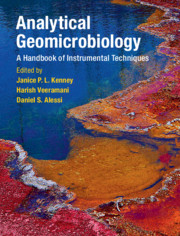Book contents
- Analytical Geomicrobiology A Handbook of Instrumental Techniques
- Analytical Geomicrobiology
- Copyright page
- Contents
- Contributors
- Foreword
- Part I Standard Techniques in Geomicrobiology
- Part II Advanced Analytical Instrumentation
- Part III Imaging Techniques
- Part IV Spectroscopy
- Part V Microbiological Techniques
- Index
- References
Part II - Advanced Analytical Instrumentation
Published online by Cambridge University Press: 06 July 2019
- Analytical Geomicrobiology A Handbook of Instrumental Techniques
- Analytical Geomicrobiology
- Copyright page
- Contents
- Contributors
- Foreword
- Part I Standard Techniques in Geomicrobiology
- Part II Advanced Analytical Instrumentation
- Part III Imaging Techniques
- Part IV Spectroscopy
- Part V Microbiological Techniques
- Index
- References
Summary
Isothermal titration calorimetry combined with surface complexation modeling is an ideal technique to provide further characterization of microbial surface reactivity towards protons and metal ions. This technique can produce enthalpies of protonation and metal ion coordination of acidic functional groups on microbial surfaces. This information is critical for understanding the thermodynamic driving force of surface complexation and provides key information for the indirect identification of surface ligands. Topics covered in this chapter include how this technique complements traditional methods of microbial surface reactivity, necessary system characterization prior to performing calorimetric experiments, how to prepare biomass and solutions for calorimetric titrations, difficult aspects of this technique, and data analysis and interpretation.
- Type
- Chapter
- Information
- Analytical GeomicrobiologyA Handbook of Instrumental Techniques, pp. 61 - 118Publisher: Cambridge University PressPrint publication year: 2019



